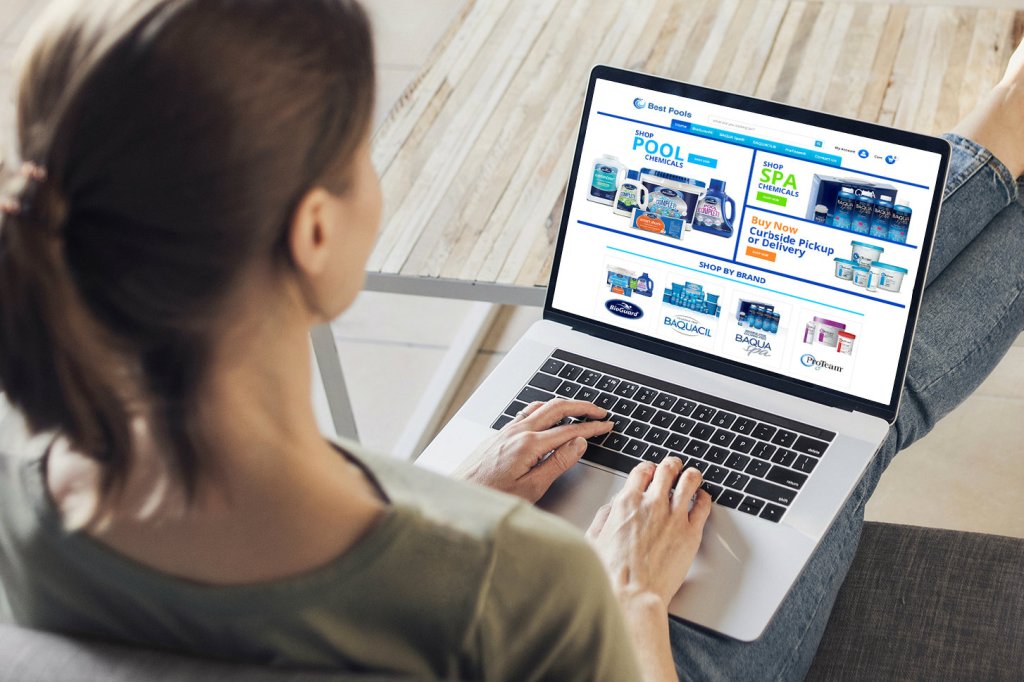Curbside pickup and home delivery have helped keep retailers in business throughout this pandemic. These contact-free services have allowed companies to provide the essential products to keep their pools clean despite restrictions or bans on brick-and-mortar operations.
For many, these operations have been managed largely through something that most brick-and-mortar retailers have only viewed at a distance — e-commerce sites. Companies rushed to put up sites that would help customers order their product and schedule times for pick or delivery.
Digital marketing firms have been helping retailers set up e-commerce sites as quickly as possible to allow the contact-free pickups and deliveries. And they’ve contracted with manufacturers, who scrambled to develop co-op materials to help their dealers with the e-commerce sites.
While the coronavirus restrictions may have presented the impetus for retailers to take this step, experts believe these sites will remain active well after the dust settles. With this in mind, digital marketing firms set up the sites to be built in stages.
“[In March and April], people wanted to get their pools open, so they wanted their chemicals. So that would be step one,” says Pam Vinje, CEO of Houston-based agency Small Screen Producer. “Step two is you can add everything else mid-season and get ready for next year.”
But many retailers had been weighing the possibility of e-commerce for years, so this may prove merely a first step for some.
“People have been telling us, ‘We’ve been meaning to do this for years, but this is what’s finally going to get us to do it,’” says Scott Reynolds, CEO of The Get Smart Group, a digital marketing agency that specializes in the pool/spa industry, based in Angels Camp, Calif. “One hundred percent of pool and spa store owners have said that.”
Not only are consumers used to major sites such as Amazon, but they’re becoming accustomed to making their supermarket purchases online as well.
“Consumer buying behavior is never going to stop,” Vinje says. “We’re never going back. This was a natural segue, [since] we were the last holdout as an industry.”
Once her customers have their sites deployed to serve the immediate need, for instance, she expects to set up subscription services that will automatically renew orders of chemicals and other repetitively purchased products over the long haul.
Here, Vinje and Reynolds offer their tips for establishing an e-commerce site that will help your company get through the current crisis and beyond.
Start with a solid e-commerce platform.
Don’t go with the least expensive platform you can find, Reynolds says. They generally cannot be customized for the needs of you and your clients. “They’ll have a terrible customer experience,” he says. “And everybody expects the Amazon experience.”
For instance, you’ll need to customize your shipping module so clients must choose curbside pickup or home delivery — and only those options, assuming you’re not shipping. The module should then also allow them to schedule a time for their pickup or delivery.
Make it easy to access from your website.
Ideally, your platform will connect your e-commerce pages to your existing website, Reynolds suggests.
Besides this, your company website should have a prominently placed prompt leading to your e-commerce pages. It should state something like “Order Products for Pickup or Delivery,” or simply “Shop Now.” Without a cue that jumps out like that, your website visitors may not know you offer these options.
Use high-quality photos.
Images of the products should be clear, large enough to see some level of detail, and bright. Viewers shouldn’t have to squint or zoom in to understand what they’re looking at.
“People don’t know what products are called,” Reynolds says. “They know they walk in your store and on the third aisle to the left is the orange thing. So good photos are very important.”
You can approach manufacturers for photos of their wares.
Test it on various formats.
Make sure the website displays correctly and is easy to navigate on smartphones and tablets, as well as desktop computers.
Augment the site with individual communication.
After an order is placed, the customer should receive an email confirming what they ordered and how they want to receive it. Additionally, Reynolds suggests, place a follow-up call for additional confirmation and to possibly upsell them on other products they hadn’t considered.
Clearly explain pick-up and delivery procedures. Should the client call ahead before parking? How do they notify you that they’ve arrived? How is product loaded into the vehicle?
Aggressively market these new services.
You’ll need all methods at your disposal to help pivot your entire customer list from visiting your stores to going online. They won’t know you offer these services unless you tell them.
“You need to be on Facebook Live every single day to show people you’re open and have what they need,” Reynolds says. “You need to email your list twice a week, every week: ‘We’re open. We’re open.’”
Some retailers have even gone back to including mailed postcards in their marketing strategies, since their customers are at home for the time being.
Create enticements to come back to the store.
When the current situation boils over, you’ll want customers to resume store visits to see the newest products available. Start laying the groundwork now. Vinje suggests providing a discount code to use during a spring or summer online sale, but then including a second code to provide a discount when they come back in person.
